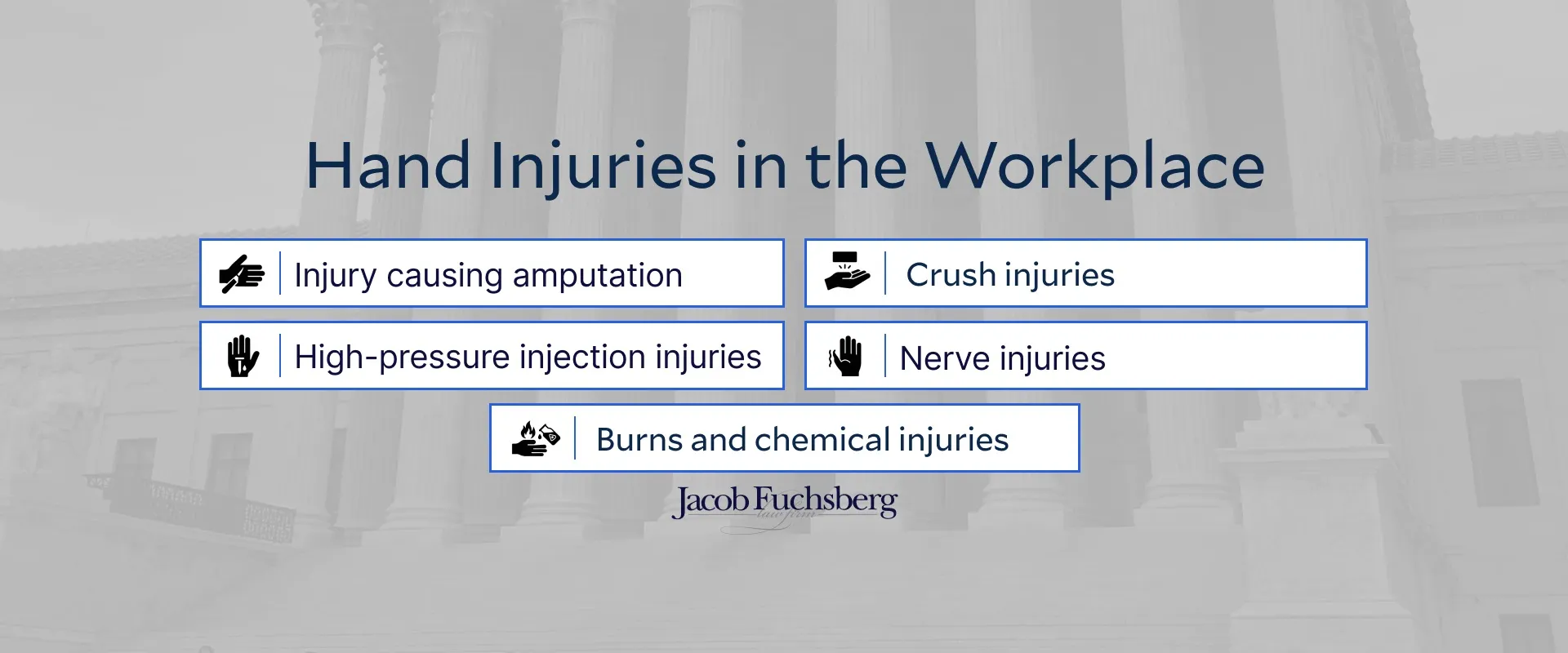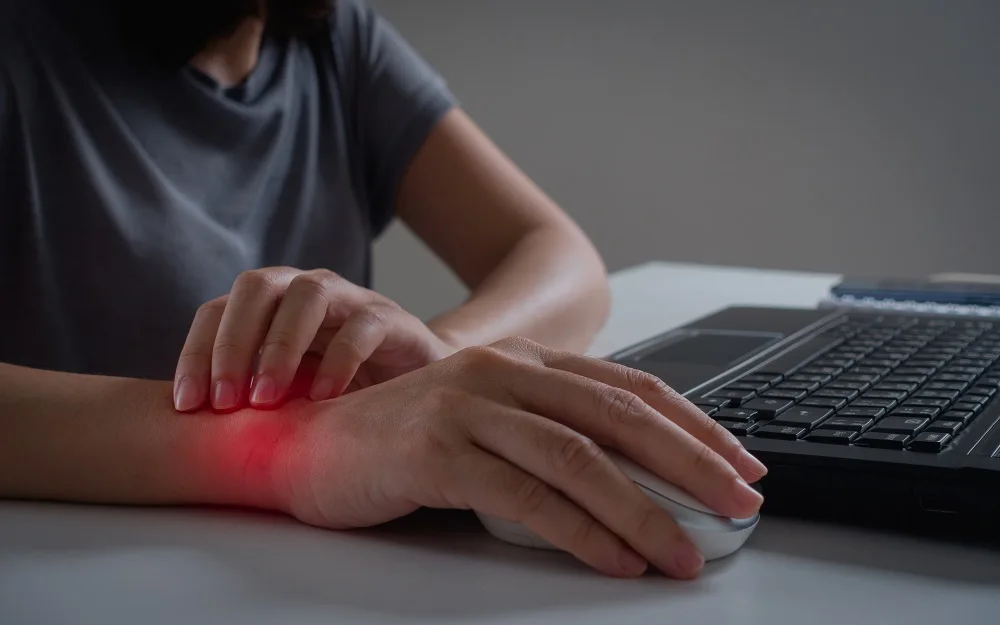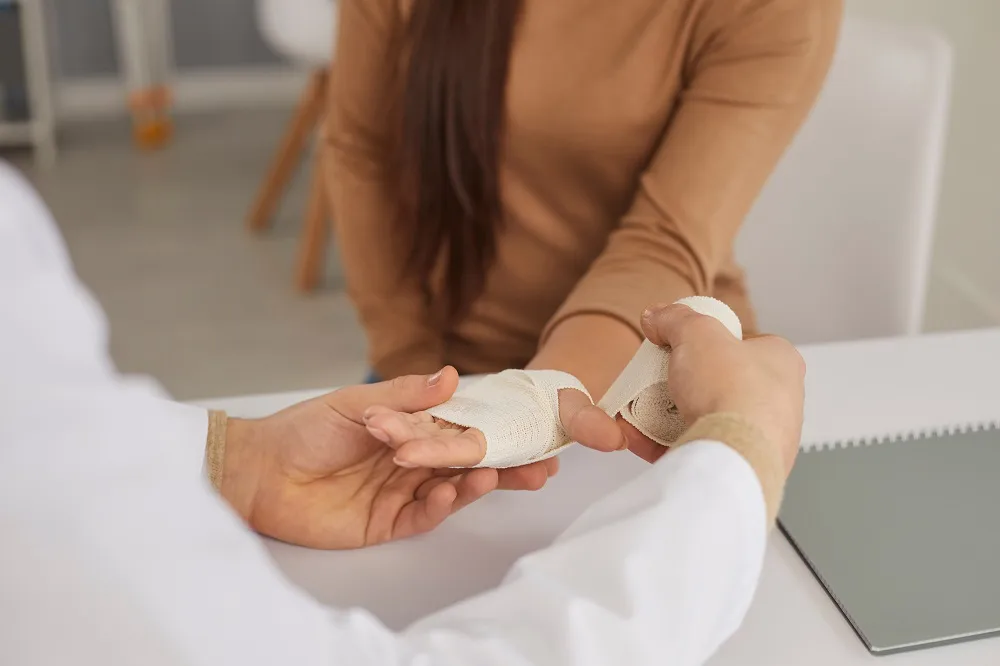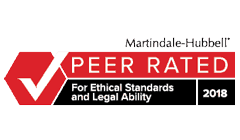Your hands are essential to nearly every job, from construction to clerical work, making them especially vulnerable to injury. Workplace hand injuries are among the most common injuries sustained on the job, and they can have a devastating impact on your ability to earn a living, perform routine tasks, and enjoy daily life. Beyond the physical trauma, these injuries often bring financial stress through rising medical bills and lost wages.
If you’ve suffered a hand injury at work, don’t face the legal and insurance process alone — our experienced New York workplace injury attorneys are here to help.
Hand Injuries in the Workplace: Statistics in New York and Beyond
Hand injuries at work are becoming increasingly common and severe. According to the U.S. Bureau of Labor Statistics, New York State’s overall workplace injury burden remains high: in 2022, private-industry employers in New York reported 138,900 all nonfatal injuries and illnesses (a total recordable case rate of 2.3 per 100 workers, versus 2.7 nationally), including 83,000 cases that involved days away from work at a rate of 1.4 per 100 workers.
Nationwide, 2021 saw 13,540 nonfatal musculoskeletal disorder cases involving severe injuries to the hand that required a median of 14 days away from work, which is an annual rate of 0.7 per 100 full-time workers. By 2022, those numbers jumped to 20,370 hand-related MSD cases (1.0 per 100 workers) and a median absence of 20 days. This sharp rise underscores the urgent need for better ergonomic practices and protective measures to keep workers’ hands safe.
Common Types of Work-Related Hand Injuries

Workplaces can expose hands to a variety of hazards, leading to common and sometimes severe injuries. The most frequently reported types include:
Amputations
Severe trauma from machinery, power tools, or crush incidents can result in partial or total amputation of fingers or the hand. These catastrophic injuries require emergency surgery and long-term rehabilitation. Victims may face permanent disability and need prosthetics or occupational retraining.
Burns and Chemical Injuries
Hands are especially exposed when working with hot surfaces, steam, molten material, or corrosive chemicals. Burns range in severity from first-degree (redness) to third-degree (deep tissue destruction). Chemical burns can continue to cause damage even after the exposure ends.
Crush Injuries
Crush injuries occur when a hand or finger is caught between moving parts, heavy objects, or collapsing materials, causing bone fractures or broken bones and severe soft tissue damage. Recovery can be lengthy, and in the most severe cases, amputation may be required.
Nerve Injuries

Nerves can be damaged by lacerations, fractures, or repetitive motion. The most common symptoms include numbness, tingling, burning pain, or complete loss of sensation. Median, ulnar, and radial nerve damage can all affect hand function, making it difficult to grip, lift, or manipulate objects. Many nerve injuries require surgery or long-term therapy.
Cuts and Lacerations
Contact with sharp edges, blades, or torn metal can slice through skin and deeper tissues. While minor nicks may heal quickly, deeper cuts often need stitches or surgery, and carry risks of nerve or tendon damage that can impair grip and dexterity.
High-Pressure Injection Injuries
Industrial hoses and grease guns can eject materials under high pressure directly into the hand, forcing oil, paint, or chemicals under the skin. These injuries may appear minor at first, but cause rapid tissue death and infection. Surgical debridement is almost always necessary, and delays can lead to amputation.
Puncture Wounds

Nails, needles, or wire can puncture the skin and drive contaminants deep into muscle or tendon tissue. These wounds may seem small, but they carry a high risk of infection, especially if not treated promptly. Punctures are common in workplace settings during carpentry, electrical work, or the handling of metal scraps.
Fractures (Broken Bones)
Fractures of the fingers, wrist, or hand bones are typically caused by slips, falls, or high-impact trauma on the job. Depending on the location and severity, these injuries may require casting, pins, or surgical plates. Complications such as joint stiffness or reduced grip strength are common if the injury isn’t treated properly.
Avulsion Injuries
An avulsion happens when skin, muscle, or connective tissue is forcibly torn away, often in accidents involving rotating machinery or jewelry caught in moving parts. These injuries are severe and may expose bone, requiring immediate surgery and possible reconstructive procedures.
Symptoms of Work-Related Hand Injuries
Work-related hand injuries can present in various ways, and early recognition of symptoms is crucial for prompt treatment and prevention of further damage. Common signs to watch for include:
- Pain and tenderness: Sharp or aching pain localized to the palm, fingers, or wrist, often worsening with movement.
- Swelling and redness: Visible puffiness, warmth, or discoloration around the injured area.
- Numbness or tingling: Pins-and-needles sensations or loss of feeling, suggesting nerve involvement.
- Stiffness and reduced range of motion: Difficulty bending or straightening fingers, opening the hand, or rotating the wrist.
- Weakness or loss of grip strength: Trouble holding tools or objects, dropping items, or diminished hand endurance.
- Visible deformity or bruising: Misaligned joints, cuts, or deep bruises signaling fractures, dislocations, or soft-tissue damage.
Causes of Work-Related Hand Injuries

Hand injuries on the job arise from a mix of workplace hazards and human factors. Understanding these root causes is the first step toward preventing hand injuries in the workplace and promoting safer practices.
- Mechanical hazards: Unguarded or malfunctioning machinery, moving parts, and loose components can suddenly crush, pinch, or sever flesh and bone.
- Sharp and puncture risks: Contact with knives, saw blades, nails, or metal shavings can lead to deep cuts and puncture wounds that risk infection and nerve damage.
- Thermal and chemical exposures: Welding, casting, or handling corrosive substances without proper gloves can cause burns, skin necrosis, and chemical injuries.
- Repetitive motion and ergonomic strain: Tasks involving constant gripping, twisting, or fine motor movements can inflame tendons, compress nerves, and lead to chronic conditions like tendonitis or carpal tunnel syndrome.
- Human error and training gaps: Insufficient training, failure to follow lockout–tagout protocols, and improper use of personal protective equipment all increase the chance of hand trauma across industries.
Prevention and Precautions for Hand Injuries at Work
Creating a safer work environment starts with vigilance and the right safety measures. Key steps include:
- Guard and secure machinery: Ensure all guards are in place and remove loose clothing, jewelry, or accessories that could become entangled.
- Inspect tools and equipment: Perform routine checks on hand tools and machinery, reporting or repairing any worn, damaged, or malfunctioning parts.
- Wear appropriate PPE: Select and use gloves, sleeves, and other protective gear tailored to the specific hazard — whether it’s cuts, chemicals, heat, or impact.
- Follow lockout–tagout procedures: De-energize equipment and follow established protocols before maintenance or cleaning tasks.
- Observe manufacturer guidelines: Read and adhere to warning labels, instruction manuals, and workplace hand safety signage.
- Stay alert and communicate: Remain focused on tasks, recognize high-risk operations, and report potential hand hazards or near-misses to supervisors.
Workplace Accident Success Stories at Jacob Fuchsberg Law Firm
At the Jacob Fuchsberg Law Firm, we handle all types of workplace injury claims — from a hand and finger injury at work to catastrophic construction‐site incidents. Below are two of our recent landmark victories:
Laborer Crushed by Steel Rods
We won a $1.45 million settlement for a 21-year-old laborer whose legs were crushed by unsecured steel rods during unloading, requiring multiple surgeries and causing permanent knee and ligament damage. We proved that the trucking company, subcontractor, and general contractor were liable.
Worker Burned in Gas Explosion
We secured a $7 million settlement for a young construction worker who suffered third-degree burns when an angle grinder ignited residual gas in an untested tank, resulting in catastrophic disfigurement, prolonged hospitalization, and permanent impairments. We sued the property owners and supervisors and forced them to pay what was owed.
FAQ
Workers’ Comp Doesn’t Cover Everything. We Do.
Workers’ compensation may pay part of your medical bills or lost wages, but it rarely reflects the true cost of your injury. If another company, contractor, or product contributed to your accident, you could be eligible for additional compensation. Our attorneys will investigate and pursue every avenue to protect your financial future.
Secure the Compensation You Deserve for Your Workplace Hand Injury! Call Us.
Contact our New York workplace injury attorneys today for a complimentary case evaluation and let us fight for the compensation you deserve.
Protect Your Rights After a Workplace Hand Injury Today
Don't struggle with the aftermath of a hand injury alone. Our New York workplace injury attorneys at the Jacob D. Fuchsberg Law Firm can evaluate your case, handle complex paperwork, and fight for maximum compensation while you focus on recovery. Schedule your free consultation today and get the comprehensive help you need to protect your future and financial well-being.

.svg)











